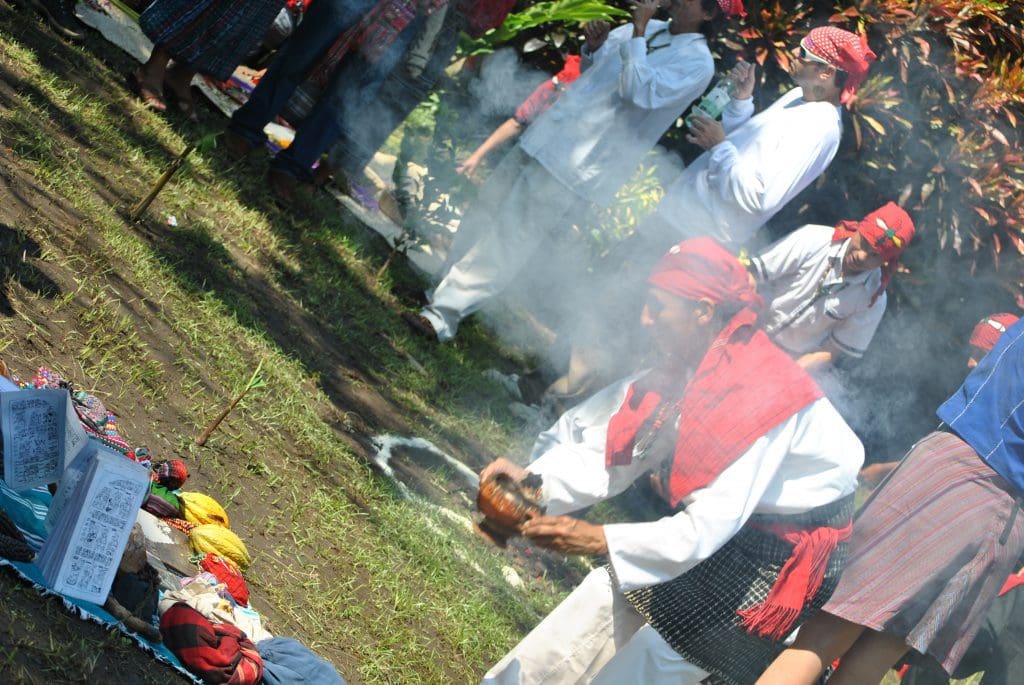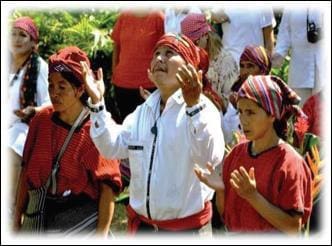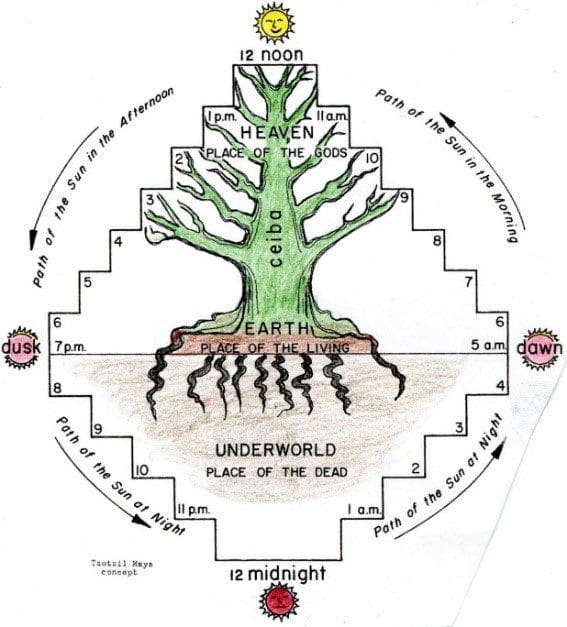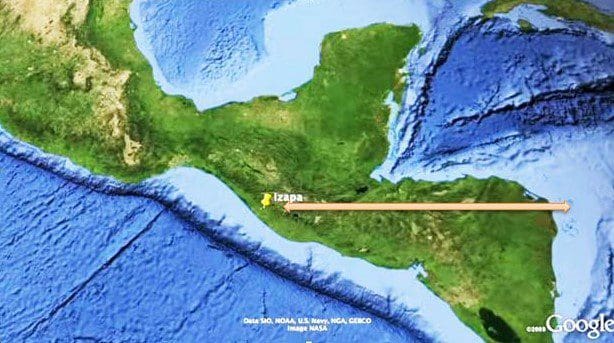Templum—Latin for Temple:
“A place set apart where the heavens can be observed.”
Maya 260-Day Calendar “Measures” the Creation of Human Life
Much of the ancient religious culture recorded on stone monuments at Izapa survives today among the living highland Maya. My wife, Cheryl, and I had the rare privilege in June of 2010, to witness traditional ceremonies – with roots of the K‘iche and Kaqchikel – conducted by Maya “Day Keepers” at Izapa for the first time in a thousand years or more. The events were organized by Georganne Johnson, Mary Lou Ridinger, and Jim Reed of The Maya Conservancy.
Our journey with the Maya Day Keepers was called “Maya to Izapa 2010.” Traveling in buses together, we met in Antigua, Guatemala, and ended at the Izapa Temple Center so the Maya spiritual leaders could see the hieroglyphic carvings where their sacred calendar began over 3,500 years ago with the Olmecs (1500 BC), followed by a new group of migrants at 500 BC (who claimed to have come across the sea from where the sun rises). Our small group of non-Maya participants consisted of fifteen Mesoamerican and Maya scholars.
Our journey took us to five different ancient temple centers from central Guatemala to southern Mexico: Iximche, Lake Atitlan, Tak’alik Ab’aj, Izapa, and Momostenango. The Ceremony of 2-3 hours was celebrated at each site, with a few variations. As we watched and made notes, there were rich similarities to the Izapa Observatory calendar including: (1) sacred space; (2) sacred ceremonial clothing depicted on six Izapa Stelae; (3) Numbers 13 x 20 = 260; (4) four cardinal directions; (5) ceremonial artifacts and objects; (6) burning of incense depicted on four Izapa Stelae, etc. (Norman 2015: 205-215).






Everyone participating in the ceremonies was given a red scarf to cover his or her head, similar to those the Maya spiritual leaders wore. The Maya wore sacred clothing – men wore white slacks and shirts, with a head covering and shawl over their shoulders, plus a woven apron and sash around the waist (Fig. 5). The women wore traditional gray skirts and red “huipils” plus the red scarf head covering. Our small group in attendance wore respectful traveling clothes, which included men and women wearing white clothing.
The 13 Maya spiritual leaders—1 priest leader plus 12 (6 men and 6 women), unwrapped incense & offerings that the women had carried on their heads. The ceremony began at an existing outdoor 3-4 foot wide round altar at five ancient temple centers (Figs. 2-4).
Group Blessings
• Tat Rigoberto Itzep Chanchovac, the leader, dedicated each ceremony to their “ancestors – the roots of the Tree of Life.” (At Tak’alik Ab’aj, the dedication included all our ancestors with a statement affirming they were with us.) (Fig. 5).
• The Maya men drew a white circle with granulated sugar on the grass (earth’s creation), then added a straight line east-west, then a crossing line north-south (Fig. 2).
• They added liquid, plants, meats, candles, and other items to the circle to represent the creation of plants and animals for the earth. (Fig. 4)








• The 12 Elders then began placing colored corn and candles at the four cardinal directions on the altar: East: red West: black North: “white” South: yellow + Sky: blue Earth: green–all symbolic colors for these directions, then they bowed to kiss the earth. (Fig. 6.)
• A prayer was given by leader, Tat Rigoberto, to dispel any evil spirits and invite the spirit of peace, followed by the lighting of the altar fire. (Fig.7).
The twelve Maya formed a square around the circular altar, three standing at each of the four cardinal directions. Everyone followed Rigoberto as he turned east and knelt on the ground to pray with hands raised. He blew a conch horn four times, then prayed and kissed the ground. We followed his movements. This was repeated facing each of the other three directions – very much in harmony with the cosmic order of the Izapa plaza monuments in 4-quarter (3-months each) directional orientations. As smoke rose from the small fire on the cosmic altar, we were taught that prayers are carried to heaven with the rising smoke, returning blessings to us. (Fig. 8)
Individual Blessings from Head to Feet
Each individual in our outside circle was blessed by a Maya spiritual leader. Holding a large candle (symbol of light) and a pine branch (Tree of Life symbol) or long-stemmed flowers, each Maya woman blessed individual men, and each Maya man blessed individual women.


• The Maya Spiritual Guide stood facing an individual, touching his/her head with a candle/pine branch to the head as they pronounced a blessing in K’iche on the head, eyes, ears, nose, and mouth.
• Then they moved the candle/pine branch to the neck and shoulders, pronouncing blessings.
• Then down each arm, down the front of the person’s body, then down each leg and each foot, pronouncing blessings for each part of the body.
• The officiator then walked behind the person to bless the back. Returning to the front, the candle/pine branch was placed on the recipient’s mouth to kiss.
As individual blessings were being pronounced, Maya Elder Tat Rigoberto prepared an incense burner bowl. Holding it, he walked in front and back of each person who had been individually blessed and blew smoke on each person to purify them and to carry their prayers heavenward.
Colored candles – red, black, white, yellow, green and blue (symbols of four directions, plus earth and sky) were passed to everyone, plus incense and other offerings that we would later put into the fire as prayer offerings.
Day Counts Measure “Creation”
After each person received these items, the twelve Mayan spiritual leaders again formed a square with three people on the four cardinal sides of the circular altar. The traditional Maya day counts began:
• One of the Maya Elders on the east side began reciting five Day Names. Each of these Day Names were repeated 13 times (5 x 13 = 65).
• This was repeated by one Maya on each of the other three sides (65 x 4 = 260). The sacred 260 days represents the 9-month human gestation period for the birth of a human baby-the summum bonum greatest creation in all of nature.
• At the end of counting in each of the four quarters, the man or woman of each group who had been counting gave a short “blessing.”


Then Tat Rigoberto proceeded to teach us aspects of living “the Maya Way”…
…..We were taught that all mankind must honor the wisdom and sacrifices of their ancestors and carry their righteous traditions on with families and extended families.
…..We were taught that life’s journey is best if we travel by twos – marriage is like the trunk of the tree, our ancestors being the roots and our children, who are the greatest gift from the heavens, are the branches of the family tree.
…..We were taught that our positive actions will bring good in our lives with the positive forces in the energies around us.
…..We were taught to care for those less fortunate, and to help others along this journey of mortality.
…..We were taught that all plants, animals, and human beings were created to recreate and fill the earth. We were taught to offer prayers at the break of each day, at noon, and in the evening with our families.
…..We were taught to pray before and after every meal with gratitude for the life-giving food we eat. Each meal of food we grow is a blessing from the Creator-God.


Following the Sacred Round 260-Day Count (measuring human gestation-creation), our spiritual guide invited each person to come to the fire altar when their birth “Day Names” were called, to put their offerings into the fire. While standing by the fire, each individual “scooped” smoke with their hands thirteen times over the front of their bodies – the number that symbolizes completion.
Group Blessings Repeated, Closing with Individual Hugs
Following our offerings, we again faced east, west, north, and south – kneeling to pray with palms up or together, then bending forward on our knees to kiss the ground –just as we had done at the beginning of the ceremony (chiasm).
Then, our Maya spiritual guides stood in line and hugged each one of us – on each side of the head (the “Maya Hug”). With this warm spirit of unity, we all truly felt like hermanos y hermanas.
The event concluded with a short testimonial for those who wished to share their feelings. I expressed gratitude that this ceremony is preserved on the ancient carved stone monuments at Izapa’s Observatory Temple which measures the sacred 260-day calendar (Norman’s May 19, 2020 Meridian article) (Video, Popol Vuh correlations, & Chiasm at: http://www.ancientamerica.org/?page_id=238.)
Momostenango Meal and Blessing
June 26, 2010 – At our last meeting with our Maya spiritual guides, we had lunch with a traditional Maya blessing before, as well as after, the meal. Following the final blessing, our spiritual leader, Tat Rigoberto, stood with tears in his eyes, thanking everyone. He said his Maya people had suffered from many wars. In past conflicts, they had lost many branches (children) and many tree trunks (parents) but have never lost the traditions and beliefs of their ancestral roots, which have helped them endure as a people. He said his people had never made weapons of war, but had fled violence. Tat Rigoberto then said, “Spread love for one another and bury your weapons of war. Care for one another and our brothers and sisters – all people of God’s creation.”


Fig. 12. Izapan Tzotzil Maya World Tree (Lowe, Lee, Martinez, 1982)
North=Heaven-Place of the Gods.
Earth=All Living Plants, Animals, & People
South=Roots – Place of the Ancestors.




Figs. 13-14. Izapa Temple Observatory – at 15º North Latitude:
Birthplace of the ancient Maya 260 Day Calendar
Each Izapa monument is positioned to observe a specific calendar date when the sun, moon, star, or planets rise in different places along the eastern Mount Tajumulco, including the Zenith Sun Passages on August 13 and April 30 that define the 260-day Calendar (Norman: May 19, 2020 Meridian “Mesoamerican antiquities” article). Observing and participating in these beautiful Maya ceremonies, so harmonious with the Izapa Temple cosmology, has opened doors to restoring a rich Maya cultural heritage from the remote past at the ancient Izapa Temple.
Notes:
Maya Ceremony article is from:
- V. Garth Norman. Cubit Connection in Ancient World Migrations. www.amazon.com 2018: pp. 24-29 and
- V. Garth Norman Izapa Sacred Space, Sculpture Calendar Codex (2015: 205-215).
- http://www.ancientamerica.org/?page_id=238



















Justin MJune 12, 2020
Thank you for sharing such a rich and spiritual experience with us! There is a great deal of symbolism and wealth of knowledge to be found within their ceremony!